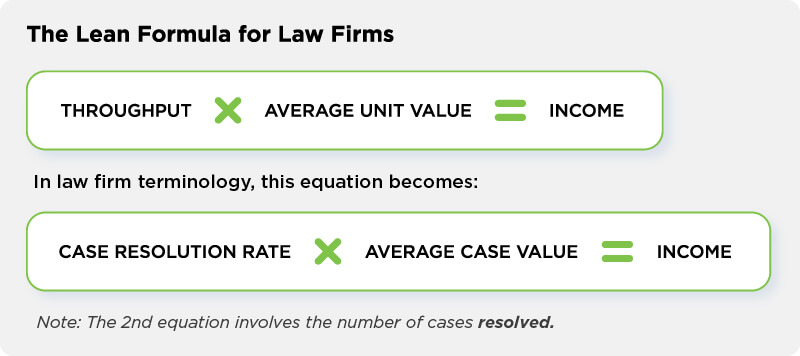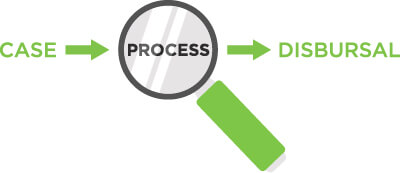4 Simple Steps to Tighten Your Law Firm’s Processes & “Lean” Into Increased Income

The “Lean” management methodology is all about continuous improvement. It was popularized by Toyota and other manufacturers, but can be applied to any business – even those that provide services, such as law firms. It recommends focusing on your firm as a system and prioritizing waste elimination, client focus, and continuous process improvement.
By focusing on these keys, you will improve client satisfaction and employee engagement, and ultimately, increase firm profits. It’s a straightforward and effective management methodology – and it can be applied successfully within your law firm. Many law firms are still suffering from the lingering effects of the pandemic, including declining intake and revenue. In The Dos and Don’ts of Law Firm Marketing in Modern Times, I offered up some key marketing strategies and tactics aimed at increasing your intake. Here, I’d like to focus at a high level on how the Lean methodology can help you make your case management and systems more efficient – from intake through resolution.
In my previous article, I confessed to a reliance on … data. It’s a well-known fact around my firm (one of the largest personal injury firms in the Southeast) that I make decisions based on data – numbers, reports, trends, research – sprinkled with empirical evidence and seasoned with real-life experience.
It should come as no surprise, then, that I also admit to a fondness for formulas. Let me share what I have learned about optimizing case management, and provide a very simple formula (and some examples) to guide your efforts.
The Lean Formula for Law Firms
Here’s one of the most simple, high-level formulas proposed in the Lean methodology, and this is one that should drive all your efforts:

Pretty straightforward, right? And it logically follows that to increase income (the right side of the equation), you need to increase the number of cases you resolve and/or the value of your cases (the left side of the equation). It’s basic math.
Let’s take it one step further. Let’s assume you are getting maximum value for your cases and direct our attention to the case resolution rate. And remember that the Lean methodology dictates that you focus on your firm as a system. Affecting the cases portion of the equation is not a matter of simply increasing your intakes (though that is part of it). It’s about improving the entire system so that cases flow more efficiently through it.
So let’s concentrate on how to use the Lean methodology to optimize your processes in order to allow more cases to flow more efficiently from intake to disbursal at your firm. This will have a positive effect on client results and firm dynamics, and it will ultimately improve firm profitability.
Putting the Lean Formula to Work
The Lean methodology looks at the firm as a system and prioritizes waste elimination, client focus, and continuous process improvement. Going back to the formula, you can improve your profitability by prioritizing these same three things.
If you can shorten the amount of time it takes to get a case to disbursal without sacrificing value, then you can increase firm income. To do this, you need to find all the parts of that process that are slow, or getting held up, and find ways to clear the bottlenecks and eliminate the delays.

This exercise of identifying and optimizing should be repeated over and over to continuously improve the overall system. Nothing is perfect, and as technology moves forward, new opportunities for optimization will appear.
Step 1: Define the Process
The idea behind the Lean methodology is that when you focus on improving your process, you can achieve higher profits. That’s what everyone wants – higher profits. The first thing you have to do to improve the process is to identify each step of the process – in writing.

- Write down every action currently being taken between the start and the finish of a case.
- Evaluate if each action is adding value to the client’s case. This will reveal steps that do not add value and can be removed from the process, which will reduce process time and result in faster case resolution.
- Remove those steps. In a Lean initiative, most of the progress will come from removing “lead time” and actions that don’t add value.
Here are some key questions to ask throughout this step:
- Can you reduce the number of steps?
- Is there waste in the process?
- Can you remove human error?
When mapping out your process, you will see that there are some steps that can’t be adjusted, such as the amount of time a defendant has to answer a complaint or the amount of time a client has to complete medical treatment. While these steps need to be identified in order to understand the complete process, the majority of improvements in the process will be made to other actions that you have control over.
Mapping out the entire process helps you identify what steps you have control over (internal constraints) and those that you do not (external constraints). Then you can focus on positively affecting the internal constraints through waste elimination, standardization, and testing.
Example: Going Paperless to Save Steps and Money
At my firm, when we went through this exercise we discovered that we were spending a lot of time shuffling paper, filing documents away to physical files, and printing medical records and other documentation received via fax or email.
Documenting the process allowed us to see just how much time and money was spent on these tasks. And since Time = Money, we adopted a paperless operating system, which eliminated the waste. Not only were we able to do away with piles of paper collected (and sometimes) forgotten about on a back desk corner, we saved tremendous time by simply downloading electronic documentation directly to our case management database, which allows for better tracking, storage, and electronic review.
Step 2: Eliminate Waste
In addition to removing as many of the non-value-added steps identified in Step 1 as you can, it’s important to eliminate all delayswithin your control and streamline your processes wherever possible. The biggest waste in any system, in any industry, is “lead time,” and “lead time” cuts into profits. In our industry, “lead time” is the time that a case is not being actively worked on … when it’s just sitting there.
Automation can help you tremendously here. In addition to minimizing human error, automation can reduce “lead time.” Your case management system should be able to show you at a glance what stage all of your cases are in, who is handling each case, and ideally send reminders to responsible parties on time-sensitive issues to help eliminate missed deadlines.
My firm uses the GrowPath case management system which has automated and customizable reminders and role-based to-do lists so every employee has up-to-date info on what needs to be done when – there is no excuse for a case to sit stagnant.
GrowPath also has many efficiency boosters that help make each employee’s “active work” (the time spent working on the case) better and faster. Capabilities such as click-to call, texting, and email are combined into one platform for streamlined communication. Centralized document management makes finding documents effortless and quick, and the drag-and-drop document functionality is a must-have time saver. We rely on these capabilities to reduce delays and eliminate system waste.
Step 3: Standardize Processes

Another way to optimize “active work” – make it faster and improve the quality – is through standardization. Take all the steps that you can impact in the process identified in Step 1 and create written procedures and checklists for each. These standards should then be followed by every team member, every time. This ensures that things are done right the first time, eliminates the need to go back and do things over again, and guarantees value for the client. Developing standard operating procedures also:
- Enhances the flow of work and increases throughput
- Reduces variability in work products
- Gets rid of bottlenecks
- Ensures consistent performance
- Allows for more accurate forecasting
Example: Using Intake Scripts to Identify Valuable Cases Quickly
A great example of how standardization can improve a law firm’s bottom line is found in the intake process. Technology is your friend here. I’ll use my firm as an example.
We standardized our intake process so that every intake specialist uses the same easy-to-use scripts and lead scoring tool for instantly qualifying potential cases. Our case management system uses the patented BuzzwordsTM feature which prompts our intake specialists with specific questions when certain terms are entered, alerting them to potential mass tort cases, and it also allows them to sign a case on the spot via text or email.
Once intakes become clients, it seamlessly converts their files to case files with a click of a button eliminating duplicate data entry and the risk of human error. The process is defined, everyone uses the same tools, our technology supports the process, and our intakes keep increasing.
GrowPath helps my firm standardize in other ways as well. Rather than relying on static, individual to-do lists, GrowPath automatically serves up dynamic reminders to our employees’ system-created to-do lists when they need to be acted upon. So everyone knows what to do and when to do it.
GrowPath’s Matter Trackers functionality ensures cases don’t sit inactive unnecessarily by highlighting languishing cases and potential delays. Document creation and administration is done within the system, which saves time and prevents errors with an automatic population of key merge fields and standardized templates.
Step 4: Test and Measure
![]()
You are not done after you have standardized your processes. These processes should be tested and retested constantly as new ideas emerge and new technologies are developed.
Measurement can be simple, too – as easy as comparing the time it takes to e-fax a document versus using a standard fax machine. Time each process, and choose the one that saves you time. You should objectively measure and compare results because (you knew it was coming) data matters. The data will drive you to accept new process refinements, and sometimes, entirely new processes.
And the good news is: the best place to find these new ideas is right in your own firm. Empower your employees to make suggestions on improving processes and listen to them. Your employees are your most important resource, and they understand the ins and outs of the work being done at your firm. Their insights into process improvements are valuable, and their commitment to your firm will grow as you listen to them and engage them in Lean methodology.
Continuous process improvements will help you deliver value to your clients, because as we all know, clients want the best results possible, as quickly as possible. You must constantly strive to shorten the amount of time it takes for your firm to deliver results. And since quicker does not automatically mean better, your testing and measuring efforts should always focus on accuracy.
So lean into getting Lean. As your firm eliminates waste and improves its processes, your employees will be more engaged, your client relationships will strengthen, and your firm profits will ultimately get, well, fatter.
Intakes are a law firm’s lifeblood. And every firm, at one time or another, faces fluctuation in its intakes. I encourage you to take a look at this straightforward guide, “The Top 7 Ways to Combat Declining Intake Calls,” for several more actionable ideas that you can implement to protect your firm’s profits.